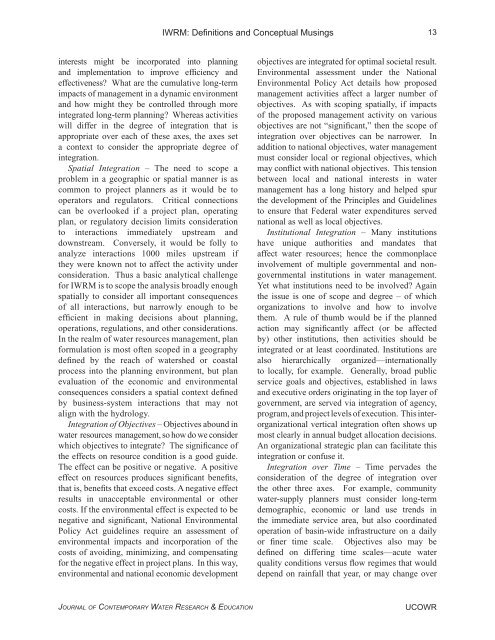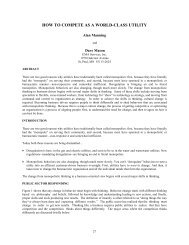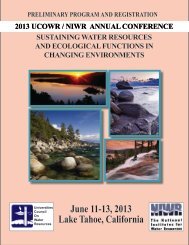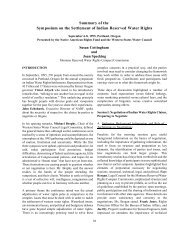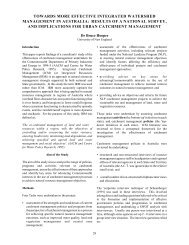12Cardwell. Cole, Cartwright, <strong>and</strong> MartinConceptual Framework for IWRMEven with a definition <strong>of</strong> IWRM as a goaldirectedprocess <strong>and</strong> underst<strong>and</strong>ing <strong>of</strong> a possiblenational goal in the U.S., questions remain aboutwhat kind <strong>of</strong> integration is necessary in waterresources management. Basic hydrology conceptsillustrate the need for integration spatially;most clearly, geographically in the concept<strong>of</strong> watershed or water catchments. The manydem<strong>and</strong>s placed on water resources also imply aneed for integration over diverse managementobjectives, <strong>and</strong>, considering the fragmented nature<strong>of</strong> water management in the U.S., a need forintegration among institutions. Finally, becausevalues change <strong>and</strong> knowledge exp<strong>and</strong>s, there is aneed to integrate management over time. Hence“integrated” water resources management can <strong>and</strong>must consider integration along at least four axes:space, objectives, institutions <strong>and</strong> time (Figure 1).1. Spatial Integration – coordination <strong>of</strong> managementfor unified achievement <strong>of</strong> commonobjectives <strong>and</strong> goals within a geographic area<strong>and</strong> among vertical strata from lithosphere toatmosphere.2. Objective Integration – coordination <strong>of</strong>management for some optimum achievement<strong>of</strong> multiple objectives, such as for agricultural,forest, soil, flood control, navigation, recreation,hydropower, water supply, <strong>and</strong> environmentalresource improvements.3. Institutional Integration – Coordination acrossm<strong>and</strong>ates, missions, policies, programs, projects,<strong>and</strong> management measures <strong>of</strong> governmental<strong>and</strong> non-governmental institutions intounified achievement <strong>of</strong> common objectives<strong>and</strong> goals.4. Temporal Integration – coordination <strong>of</strong>activities on different time scales—fromdaily operations to considerations decadesaway—into unified achievement <strong>of</strong> commonobjectives <strong>and</strong> goals.These axes place broad dimensions on theimplementation <strong>of</strong> integrated water resourcesmanagement. What should the spatial extent <strong>of</strong> ananalysis be to ensure achievement <strong>of</strong> common goals<strong>and</strong> objectives? What objectives need to be consideredto enhance the success <strong>of</strong> management decisions?What other institutions, policies, programs, orFigure 1. Conceptual framework for IWRM using four axes.UCOWRJOURNAL OF CONTEMPORARY WATER RESEARCH & EDUCATION
IWRM: Defi nitions <strong>and</strong> Conceptual Musings13interests might be incorporated into planning<strong>and</strong> implementation to improve efficiency <strong>and</strong>effectiveness? What are the cumulative long-termimpacts <strong>of</strong> management in a dynamic environment<strong>and</strong> how might they be controlled through moreintegrated long-term planning? Whereas activitieswill differ in the degree <strong>of</strong> integration that isappropriate over each <strong>of</strong> these axes, the axes seta context to consider the appropriate degree <strong>of</strong>integration.Spatial Integration – The need to scope aproblem in a geographic or spatial manner is ascommon to project planners as it would be tooperators <strong>and</strong> regulators. Critical connectionscan be overlooked if a project plan, operatingplan, or regulatory decision limits considerationto interactions immediately upstream <strong>and</strong>downstream. Conversely, it would be folly toanalyze interactions 1000 miles upstream ifthey were known not to affect the activity underconsideration. Thus a basic analytical challengefor IWRM is to scope the analysis broadly enoughspatially to consider all important consequences<strong>of</strong> all interactions, but narrowly enough to beefficient in making decisions about planning,operations, regulations, <strong>and</strong> other considerations.In the realm <strong>of</strong> water resources management, planformulation is most <strong>of</strong>ten scoped in a geographydefined by the reach <strong>of</strong> watershed or coastalprocess into the planning environment, but planevaluation <strong>of</strong> the economic <strong>and</strong> environmentalconsequences considers a spatial context definedby business-system interactions that may notalign with the hydrology.Integration <strong>of</strong> Objectives – Objectives abound inwater resources management, so how do we considerwhich objectives to integrate? The significance <strong>of</strong>the effects on resource condition is a good guide.The effect can be positive or negative. A positiveeffect on resources produces significant benefits,that is, benefits that exceed costs. A negative effectresults in unacceptable environmental or othercosts. If the environmental effect is expected to benegative <strong>and</strong> significant, National EnvironmentalPolicy Act guidelines require an assessment <strong>of</strong>environmental impacts <strong>and</strong> incorporation <strong>of</strong> thecosts <strong>of</strong> avoiding, minimizing, <strong>and</strong> compensatingfor the negative effect in project plans. In this way,environmental <strong>and</strong> national economic developmentobjectives are integrated for optimal societal result.Environmental assessment under the NationalEnvironmental Policy Act details how proposedmanagement activities affect a larger number <strong>of</strong>objectives. As with scoping spatially, if impacts<strong>of</strong> the proposed management activity on variousobjectives are not “significant,” then the scope <strong>of</strong>integration over objectives can be narrower. Inaddition to national objectives, water managementmust consider local or regional objectives, whichmay conflict with national objectives. This tensionbetween local <strong>and</strong> national interests in watermanagement has a long history <strong>and</strong> helped spurthe development <strong>of</strong> the Principles <strong>and</strong> Guidelinesto ensure that Federal water expenditures servednational as well as local objectives.Institutional Integration – Many institutionshave unique authorities <strong>and</strong> m<strong>and</strong>ates thataffect water resources; hence the commonplaceinvolvement <strong>of</strong> multiple governmental <strong>and</strong> nongovernmentalinstitutions in water management.Yet what institutions need to be involved? Againthe issue is one <strong>of</strong> scope <strong>and</strong> degree – <strong>of</strong> whichorganizations to involve <strong>and</strong> how to involvethem. A rule <strong>of</strong> thumb would be if the plannedaction may significantly affect (or be affectedby) other institutions, then activities should beintegrated or at least coordinated. Institutions arealso hierarchically organized—internationallyto locally, for example. Generally, broad publicservice goals <strong>and</strong> objectives, established in laws<strong>and</strong> executive orders originating in the top layer <strong>of</strong>government, are served via integration <strong>of</strong> agency,program, <strong>and</strong> project levels <strong>of</strong> execution. This interorganizationalvertical integration <strong>of</strong>ten shows upmost clearly in annual budget allocation decisions.An organizational strategic plan can facilitate thisintegration or confuse it.Integration over Time – Time pervades theconsideration <strong>of</strong> the degree <strong>of</strong> integration overthe other three axes. For example, communitywater-supply planners must consider long-termdemographic, economic or l<strong>and</strong> use trends inthe immediate service area, but also coordinatedoperation <strong>of</strong> basin-wide infrastructure on a dailyor finer time scale. Objectives also may bedefined on differing time scales—acute waterquality conditions versus flow regimes that woulddepend on rainfall that year, or may change overJOURNAL OF CONTEMPORARY WATER RESEARCH & EDUCATIONUCOWR
- Page 3: Journal of ContemporaryWater Resear
- Page 6 and 7: 2Bruce Hooperinstitutional, and tem
- Page 11 and 12: IWRM: Governance, Best Practice, an
- Page 13 and 14: IWRM: Defi nitions and Conceptual M
- Page 15: IWRM: Defi nitions and Conceptual M
- Page 19: IWRM: Defi nitions and Conceptual M
- Page 22 and 23: 18Cardwell. Cole, Cartwright, and M
- Page 24 and 25: 20Mostert26 water boards responsibl
- Page 26 and 27: 22MostertTable 1. Third National Wa
- Page 28 and 29: 24MostertImplementationThe ambitiou
- Page 30 and 31: 26MostertBiswas, A. K. 2004b. Respo
- Page 32 and 33: 28UNIVERSITIES COUNCIL ON WATER RES
- Page 34 and 35: 30Ashton, Turton, and Rouxresource
- Page 36 and 37: 32Ashton, Turton, and Rouxassumptio
- Page 38 and 39: 34Ashton, Turton, and RouxEffective
- Page 40 and 41: 36UNIVERSITIES COUNCIL ON WATER RES
- Page 42 and 43: 38Hussey and Doversin water policy
- Page 44 and 45: 40Hussey and Dovers1994 Council of
- Page 46 and 47: 42Hussey and Doversestablished Thes
- Page 48 and 49: 44Hussey and DoversTable 1. Typolog
- Page 50 and 51: 46Hussey and Doversassessment appro
- Page 52 and 53: 48Hussey and Doverspolicy goals.Bey
- Page 54 and 55: 50Hussey and DoversFrawley, K. 1994
- Page 56 and 57: 52Mitchelloften took three to four
- Page 58 and 59: 54Mitchelltree preservation plans;
- Page 60 and 61: 56UNIVERSITIES COUNCIL ON WATER RES
- Page 62 and 63: 58Genskow and Borna series of chall
- Page 64 and 65: 60Genskow and BornTable 1. Watershe
- Page 66 and 67:
62Genskow and Bornthe first Dungene
- Page 68 and 69:
64Genskow and BornWashington, DC.Ko
- Page 70 and 71:
66Green and Fernández-BilbaoWithin
- Page 72 and 73:
68Green and Fernández-Bilbaosubjec
- Page 74 and 75:
70Green and Fernández-Bilbaoinflue
- Page 76 and 77:
72Green and Fernández-BilbaoBerbel
- Page 78 and 79:
74UNIVERSITIES COUNCIL ON WATER RES
- Page 80 and 81:
76BallweberEstablish AdvisoryCommit
- Page 82 and 83:
78Ballweberattributes in others (Ch
- Page 84 and 85:
80UNIVERSITIES COUNCIL ON WATER RES
- Page 86 and 87:
82Barreiraand ground water. To this
- Page 88 and 89:
84Barreirawith other states for int
- Page 90 and 91:
86UNIVERSITIES COUNCIL ON WATER RES
- Page 92 and 93:
88Davis and ThrelfallResource Manag
- Page 94 and 95:
90Davis and ThrelfallTable 2. Thirt
- Page 96 and 97:
92Davis and Threlfallby regional an
- Page 98 and 99:
94Davis and Threlfallenforcement, a
- Page 100 and 101:
96Davis and Threlfallhusbandry prac
- Page 102 and 103:
98Davis and ThrelfallNew Zealand: T
- Page 104 and 105:
100UNIVERSITIES COUNCIL ON WATER RE
- Page 106 and 107:
102Lamoree and van SteenbergenIt is
- Page 108 and 109:
104Lamoree and van Steenbergenand n
- Page 110 and 111:
106Lamoree and van Steenbergeninter
- Page 112 and 113:
108BourgetWorks Planner Capability
- Page 114 and 115:
110Bourgetwith over 600 people resp
- Page 116 and 117:
112Bourgetgovernment’s intrusion
- Page 118 and 119:
114Bourget4.management, drought man
- Page 120 and 121:
116McKayFigure 1. The four paradigm
- Page 122 and 123:
118McKay4. Paradigm 4 (which commen
- Page 124 and 125:
120McKaythree main functions:1. ass
- Page 126 and 127:
122McKayState Implementation of the
- Page 128 and 129:
124McKayTable 2. Corporate governan
- Page 130 and 131:
126McKayFigure 4. Qu. 26 - The ESD
- Page 132 and 133:
128McKayFigure 7. Qu.93- This organ
- Page 134 and 135:
130McKayBrundtland Report. 1987. Ou
- Page 136 and 137:
132UCOWR BOARD OF DIRECTORS/COMMITT
- Page 138 and 139:
134BENEFITS OF UCOWR MEMBERSHIPThe
- Page 140 and 141:
136Past Issues of the Journal of Co
- Page 142 and 143:
138Academic Organizations Membershi
- Page 144 and 145:
140Individual Membership Applicatio
- Page 146 and 147:
Universities Council on Water Resou
- Page 148:
Integrated Water Resources Manageme


